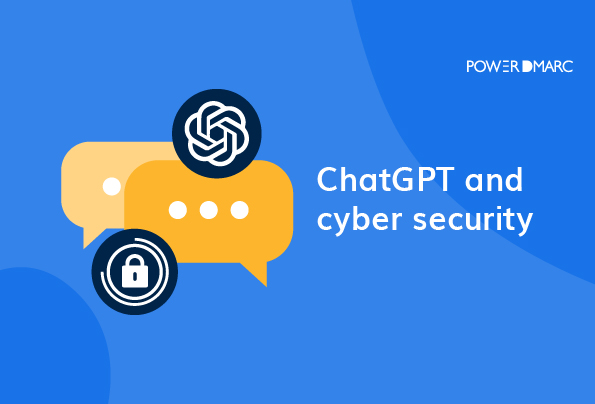Cybersecurity is a growing concern in today’s world, as the number of cyber-attacks increases. As technology becomes more integrated into our lives, it is critical to have systems in place to protect ourselves from malicious attacks. The use of artificial intelligence, specifically the ChatGPT language model, could be one potential solution to this problem. We will look at how ChatGPT can help improve cybersecurity in this blog.
Key Takeaways
- ChatGPT can enhance cybersecurity training by educating users about social engineering and phishing attacks.
- Utilizing ChatGPT for data analysis can help organizations spot trends and potential threats before they escalate.
- ChatGPT offers practical advice and best practices for improving personal and organizational cybersecurity hygiene.
- Cyber attackers can exploit ChatGPT to develop malware, crack passwords, and generate convincing phishing messages.
- While ChatGPT can aid in understanding email authentication protocols, implementing them requires a dedicated service provider.
ChatGPT: An Attacker’s Ally or Annihilator?
Leveraging ChatGPT to Improve Cybersecurity
1. For Training Purposes
To begin, it is important to note that ChatGPT is a machine-learning model that has been trained on massive amounts of text data. This means that it is well-versed in a wide range of topics, including cybersecurity. This knowledge can be used to improve cybersecurity in a variety of ways.
ChatGPT can also be used to improve cybersecurity by providing education and training. One of the biggest challenges in cybersecurity is the human element – people can inadvertently create vulnerabilities by clicking on suspicious links or falling for phishing scams. ChatGPT can be used to develop countermeasures against sophisticated social engineering attacks, including those involving AI Humanizers, by analyzing and predicting their behavior patterns.
Simplify Cybersecurity with PowerDMARC!
2. Analyze Data and Identify Trends
Finally, ChatGPT statistics can be used to analyze data and identify trends. This can help organizations proactively identify potential threats before they become a problem. For example, ChatGPT could be used to analyze social media posts and identify patterns of behavior that are associated with cyber-attacks. This information could then be used to strengthen defenses and prevent attacks from occurring.
3. Cybersecurity Advice and Suggestions
As an AI language model, ChatGPT can provide you with information and advice to help you improve your cybersecurity. Here are some ways ChatGPT can assist you:
- Provide you with general cybersecurity knowledge: ChatGPT can give you a comprehensive understanding of the basics of cybersecurity, including the most common threats and how to protect yourself from them.
- Help you identify vulnerabilities: ChatGPT can assist you in identifying the areas of your cybersecurity where you are most vulnerable, such as weak passwords or outdated software.
- Offer advice on best practices: ChatGPT can provide you with best practices for maintaining good cybersecurity hygiene, such as keeping your software up to date, avoiding suspicious emails, and using strong passwords.
- Suggest tools and resources: ChatGPT can recommend tools and resources that can help you protect your computer and data, such as antivirus software, firewalls, and encryption.
- Answer your questions: ChatGPT can answer your specific questions about cybersecurity, such as how to secure your home network, how to recognize phishing scams, and how to protect your online accounts.
Overall, ChatGPT can provide you with valuable information and guidance to help you improve your cybersecurity and keep your data safe.
Here are some examples of the same:
Example 1: Asking for cybersecurity suggestions
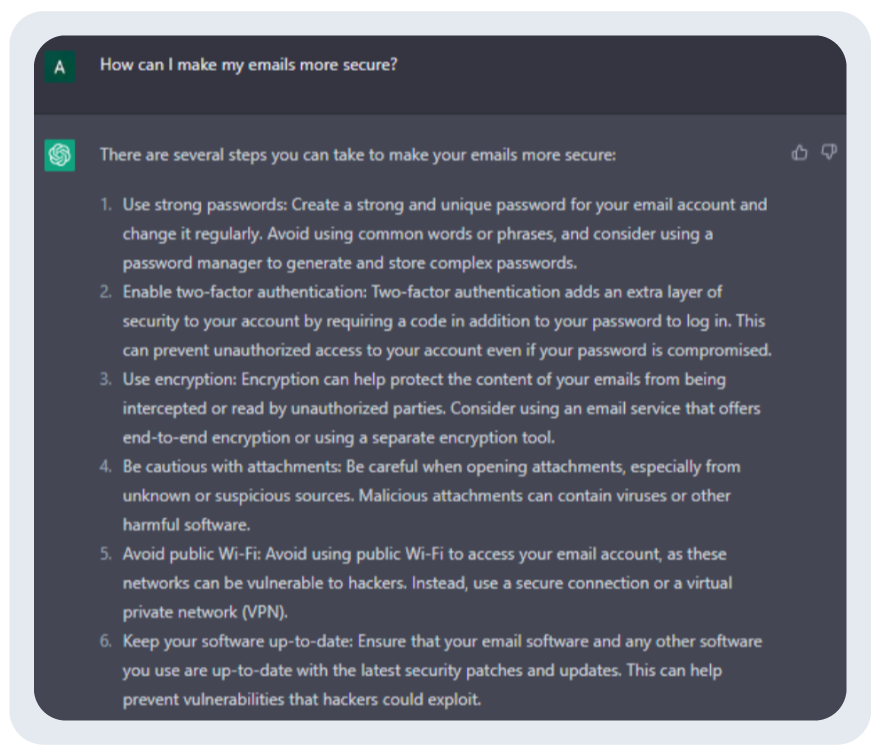
Example 2:
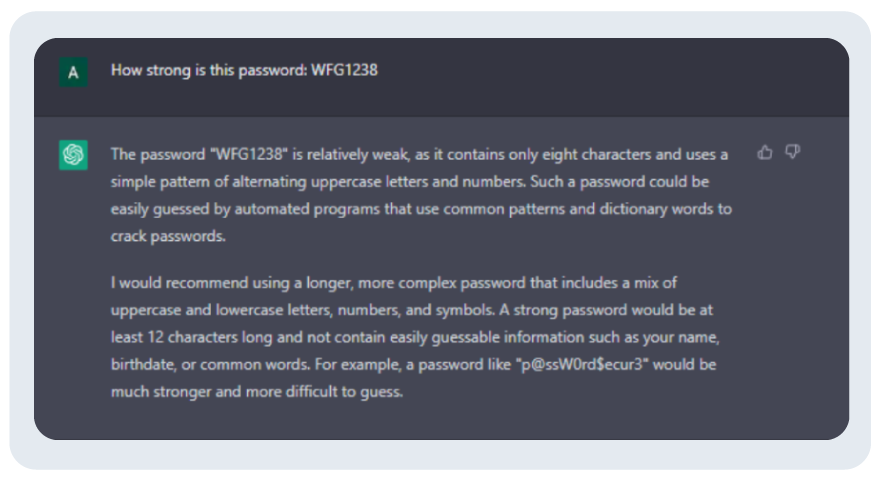
Example 3: Offering Advice on Best Practices
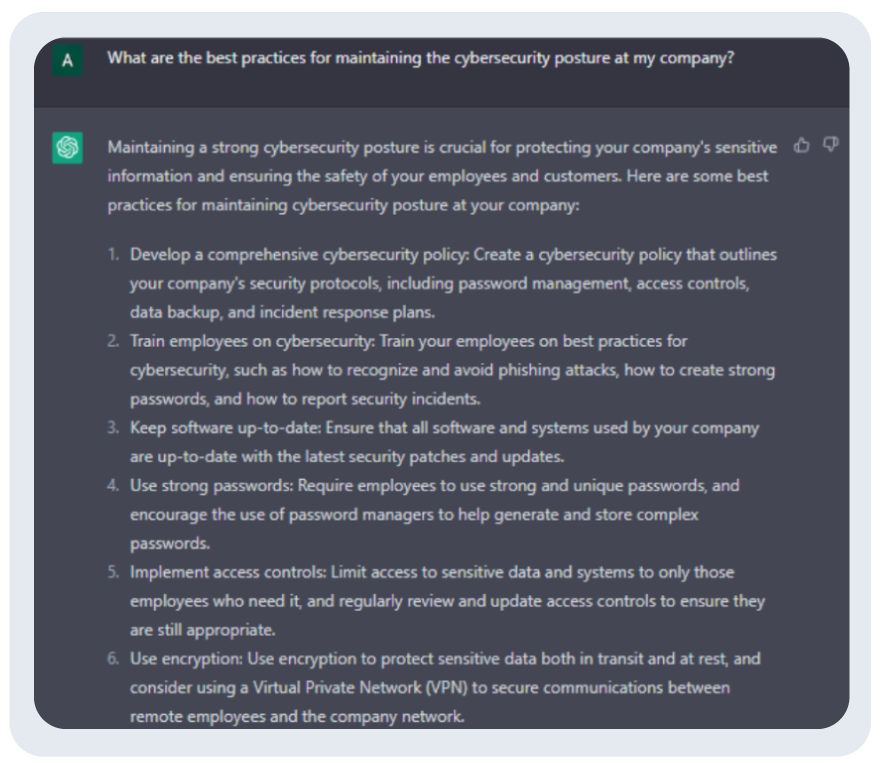
Example 4: Suggesting Tools and Resources
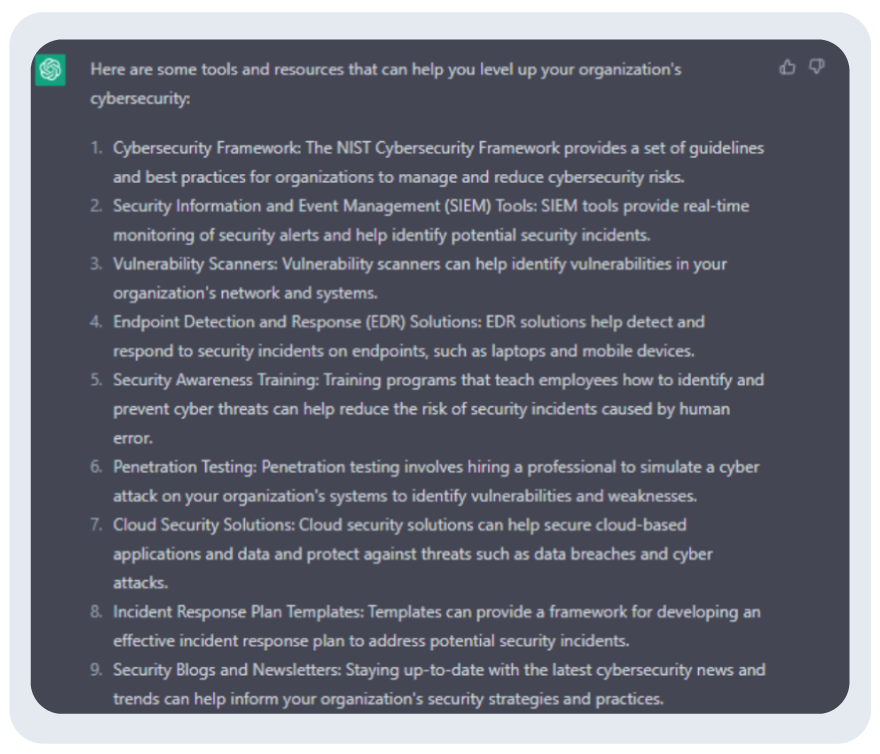
Example 5: Answering your questions
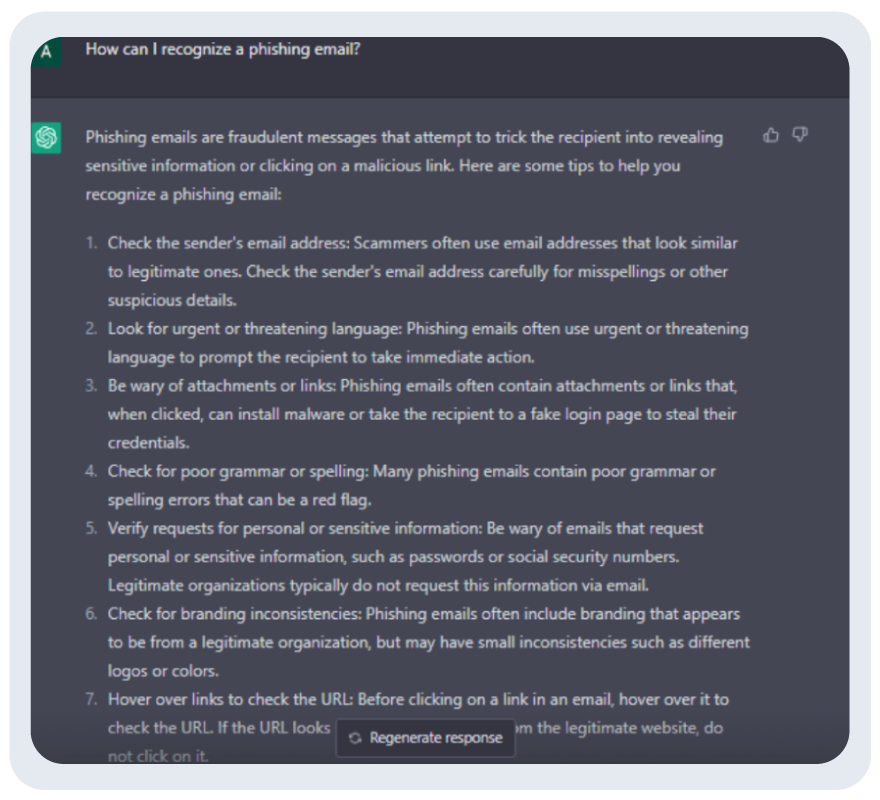
Leveraging ChatGPT for Malicious Intent
ChatGPT, as an AI language model, can be used by cyber attackers for malicious intent in a variety of ways:
- Malware development: Cyberattackers can use ChatGPT to generate malicious code for malware that is difficult for traditional anti-virus software to detect. They can use the model to write code that circumvents security measures and installs malware on the devices of victims.
- Password cracking: Cyberattackers can use ChatGPT to crack passwords or security questions by generating a large number of possible combinations based on the victim’s known personal information.
- Phishing Attacks: Cyberattackers can use ChatGPT to generate convincing phishing emails or messages that appear to come from legitimate sources. The attacker can use ChatGPT to mimic the writing style and tone of the person they are impersonating, making the victim’s detection of the scam more difficult.
- Social Engineering: ChatGPT can be used to create fake social media profiles or AI chatbots that can be used to trick people into sharing sensitive information or performing actions that could jeopardize their security.
How can ChatGPT aid you in your Email Authentication journey?
While ChatGPT can provide domain owners with useful and comprehensive information on existing email authentication protocols like DMARC, SPF, DKIM, and MTA-STS, it cannot help you implement these measures on the DNS level.
For that, you need a reliable email authentication service provider like PowerDMARC or go for manual implementation that requires a lot of time, effort, and advanced knowledge of the protocols.
How can we help?
PowerDMARC is a cloud-based email authentication and security platform that can aid in the implementation of email authentication in a variety of ways:
- PowerDMARC provides an easy-to-use platform for organizations to deploy DMARC across their email domains. DMARC is an email authentication protocol that prevents email spoofing and phishing attacks by utilizing SPF and DKIM. Organizations can use PowerDMARC to quickly set up DMARC records and monitor email authentication status across their domains.
- PowerDMARC provides an interface to assist organizations in managing their email authentication DNS records. PowerDMARC makes it easier for organizations to maintain email authentication and prevent spoofing and phishing attacks by simplifying the process of creating and managing SPF, DKIM, DMARC, MTA-STS, TLS-RPT, and BIMI records.
- PowerDMARC provides detailed email reporting and analytics, providing organizations with insights into their email traffic and authentication status. Reports on DMARC authentication results, SPF and DKIM alignment, and email sources are provided by the platform, assisting organizations in identifying potential threats and taking corrective action.
- PowerDMARC integrates with threat intelligence feeds, giving organizations real-time information about known email threats. This enables organizations to respond quickly to emerging threats and prevent potential attacks.
We can help organizations implement and maintain strong email authentication, preventing email spoofing and phishing attacks, and ensuring the security of their email communications.
- What Is Spam Email? Definition, Types & How to Stop It - July 11, 2025
- How to Tell if an Email Is Fake: Red Flags to Watch Out For - July 11, 2025
- Have I Been Pwned? Steps to Check, Fix, and Stay Safe - July 11, 2025

